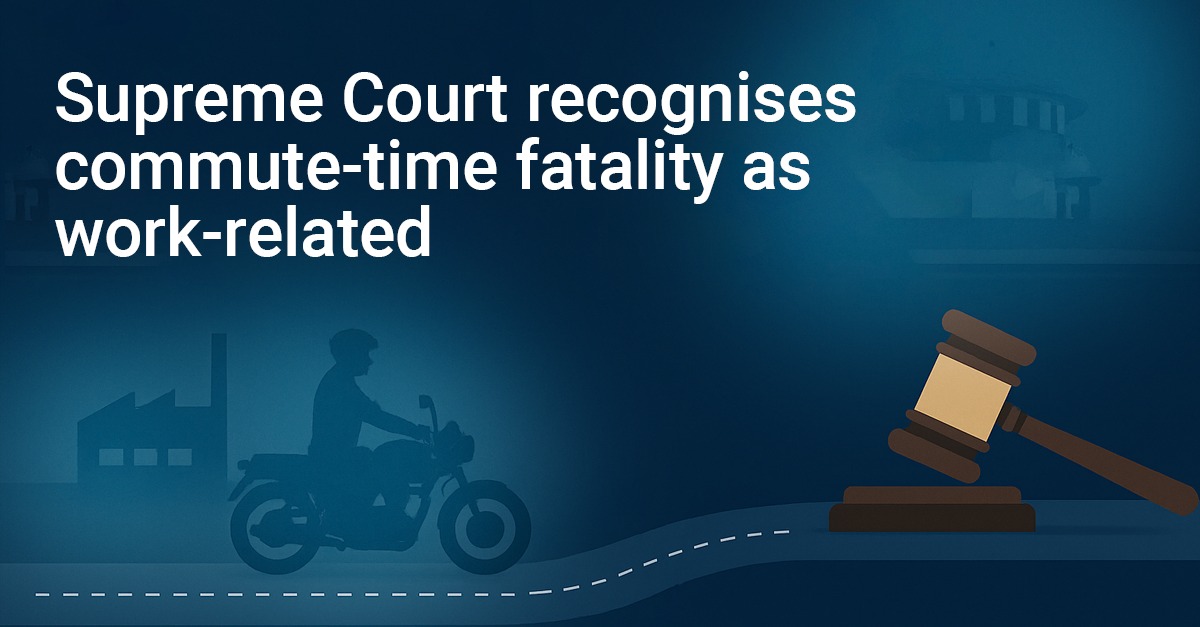Supreme Court recognises commute-time fatality as work-related

Introduction
The Supreme Court in Daivshala and Others v. Oriental Insurance Company Ltd. and Another[1] settled a long-standing legal question, can a fatal accident during an employee’s commute to work be treated as arising out of and in the course of employment under the Employees’ Compensation Act, 1923 (“ECA”)? The Supreme Court held, that and reasonable connection between the journey and the job.
Table of Contents
Brief facts
The case revolved around deceased employee, a watchman at a sugar factory, who tragically lost his life in a road accident while riding his motorcycle to report for duty in the early hours. The accident took place about five kilometres from the factory. His family was left without a breadwinner sought compensation under the ECA. The Commissioner under the Workmen’s Compensation agreed, recognising the death as employment-related and awarding over ₹3 lakh in compensation. But this relief was short-lived. The Bombay High Court, relying on the earlier precedent of Francis De Costa v. Regional Director, ESI Corporation (1996)[2], overturned the Commissioner’s order, holding that since the accident happened outside the factory premises, it fell outside the bounds of employment.
Supreme Court’s view
The Supreme Court chose not to stick to lines drawn in older precedents. The Supreme Court drew attention to Section 51E of the Employees’ State Insurance Act, 1948 (“ESI Act”) a provision introduced in 2010, which clarifies that accidents while commuting to or from work are deemed to arise out of and in the course of employment, provided a “nexus” exists in terms of time, place, and circumstances. Even though the provision came later, the Supreme Court held that it was explanatory in nature and could apply retrospectively to clarify how such phrases should have always been interpreted.
Implications
The judgment goes a step further to remind us that the ECA and ESI Act are not isolated islands they are statutes in pari materia, forming part of a broader legal framework built to safeguard workers. They must be read in harmony, and their language must be interpreted not narrowly or technically, but with compassion and common sense. In that spirit, the Supreme Court revitalised the doctrine of notional extension, a principle that allows the boundary of employment to stretch beyond the workplace gate when an employee is performing an act reasonably connected to their duties. Reporting for work in the early morning as part of one’s shift certainly falls within this zone.
The Supreme Court found that the deceased employee was not wandering off on a frolic of his own he was on a direct, timely commute to his job, with no evidence of deviation or delay. This established the necessary nexus. By restoring the Commissioner’s order and setting aside the High Court’s view, the Supreme Court sent a clear message: when in doubt, the benefit must go to the worker.
From an employer’s standpoint, this judgment signals a pivotal shift. Companies will now need to exercise greater caution in assessing workplace risks beyond the factory floor or office premises. The expanded legal interpretation of ‘course of employment’ may include commute-time incidents means organisations may face increased liability for events occurring outside their direct control.
Employers should consider:
- Revisiting their internal policies, including accident reporting protocols and insurance coverage, to ensure that they comprehensively address such extended risks;
- Need for robust safety advisories, transportation support (where applicable);
- Awareness measures for employees commuting during odd hours or through high-risk routes.
[1] Civil Appeal No. 6986 of 2015 ( Special Leave Petition (C) No. 16573 of 2012), Supreme Court of India.
[2] (1996) 6 SCC 1
By entering the email address you agree to our Privacy Policy.